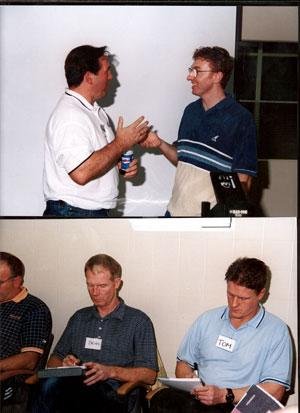
This case study looks at how Jaguar, one of the world’s most prestigious car manufacturers, has been involved in a culture change programme to create new ways of working for the twenty-first century.
Corporate culture reflects the personality of an organisation. It includes the shared beliefs and the policies and procedures that determine the ways in which the organisation and its people behave and solve business problems. You can quickly get a feel for the culture of an organisation just by looking around and talking to the people who work for it. For example, some organisations are very dynamic and their people are encouraged to take risks. Others are backward looking and rarely take risks.
The culture of the organisation provides the meaning, direction and clarity (the human glue) that drives the business to achieve its goals. From time to time it becomes necessary to change the culture of an organisation to make sure that it fits the environment in which the organisation operates.
Changes in the car industry
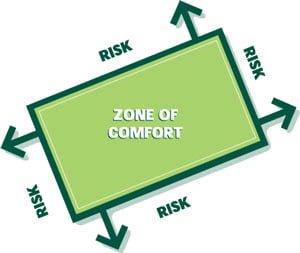
The car industry has changed dramatically. At the start of the twentieth century, the industry was dominated by the achievements of Henry Ford who created a manufacturing system that was known as Fordism. In Fordist organisations, the manufacturing system was geared towards creating standardised products such as the Model T Ford.
The needs of the production line determined the life of the production line worker. Workers knew exactly what was expected of them and were given set periods of time to carry out particular operations. This system was very successful, lowered production costs and brought the motor car within the budget of the ordinary family in the west. However, during the 1980s the car industry was transformed by new manufacturing approaches from Japan. Japanese success was based partly on the competitive prices they were able to ask for their products and services, but mainly on their quality.
The concept of Total Quality Management (TQM) was developed in the US after the end of World War Two but was implemented first in Japan. It changed the balance of world trade and led many companies in the west to rethink their attitudes, policies and structure. TQM can only operate when responsibility and power are delegated downwards through all levels of the organisation.
Responding to changing demands
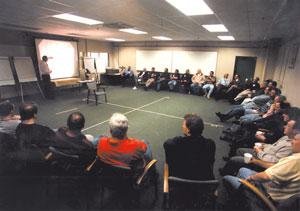
As the world became more competitive, organisations had to respond quickly to rapidly changing demands. They could no longer rely on producing standardised products but had to manage a wider portfolio of associated products. This demanded increased flexibility, and the active cooperation of a versatile and increasingly skilled workforce. In the 1980s and the 1990s, many American and European companies adopted more flexible Japanese ways of working so they could respond quickly to changing market conditions.
In recent years the world car industry has been rationalised. Instead of hundreds of car companies world-wide, there are ten major global players. Part of this rationalisation has seen the development of a new Ford group of companies. In the 1990s Ford took control of Jaguar. It recently overhauled the Halewood plant to produce the new X400 Jaguar and created a new way of working. Many of the employees at Halewood had previously produced Ford Escorts using traditional manufacturing techniques, in which they were not encouraged to show initiative. They now needed to learn new approaches to work which involved empowerment and flexibility; more responsibility was given to the operative at the sharp end of production. What better place to introduce a culture change than by starting with a prestige marque like Jaguar?
Strategy
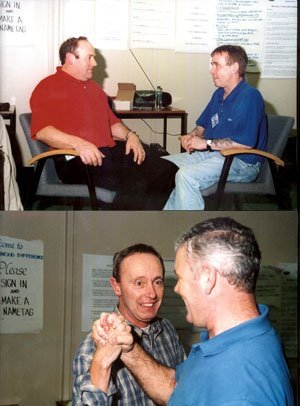
To manage the change process at the Jaguar plant, Ford worked closely with a consultancy group called Senn Delaney Leadership. Senn Delaney believes that it is important to align the culture, structure and the strategy of an organisation. The organisation that seeks to change its strategy without changing its culture will experience resistance to change. The successful management of change is crucial.
The strategy of the organisation includes the overall business direction and the plan to achieve it. Structure includes the organisational design and model, the processes, systems, policies and procedures that support it. Organisations involved in the change process often focus on strategy and structure and neglect culture change. As a result, the existing culture acts like an invisible anchor that drags the business down.
Teamwork approach
In the motor industry in the early 1990s, many employees were not used to making decisions for themselves. They expected to be told what to do. This slowed down change when companies wanted to move on to self-managed teamwork approaches. In the 1990s Jaguar overhauled its approaches to work to create an environment in which employees were encouraged to ‘take ownership’. They would be involved in managing a process of continuous improvement that revolved around ‘lean production’.
Lean production involves standardising work processes to cut out waste. The standard set is the best identified method of operation at a particular moment in time. This standard is continuously improved. The key to lean production is to identify which production processes add value. Processes which do not add value are cut out so that labour and machinery can focus on added value activities. To introduce lean production at Halewood it was necessary to transform existing attitudes in the workforce. Employees had to take responsibility for introducing new working methods and to continuously suggest further improvements. They would work in small teams with a team leader.
The Jaguar Vision

To transform working patterns at Halewood, a Halewood Difference Programme was introduced based on a new vision and set of guiding values and behaviours. Jaguar targets industry leadership in quality, value for money, customer care and human resource management. Compatible with these targets the vision for the Halewood body and assembly plant is:
- a world class vehicle manufacturing facility producing Jaguar cars for the discerning luxury car buyer, providing maximum job satisfaction and security
- a safe environment in which highly motivated employees demonstrate a pride, passion in the product and an earnest desire to drive continuous improvements
- a management that respects its employees and is committed to best practices in terms of fairness, recruitment, communications, training, education, diversity and individual employee welfare
- management and employees working together to achieve shared goals, volume and job growth opportunities
- the leading manufacturer in the community, fulfilling environmental responsibilities and proactive in supporting local initiatives.
Guiding values and behaviours set out a picture of how people within the plant would work with each other and with external customers on a day-today basis. This provided the basis for a new organisational culture. On a day-to-day basis Halewood people would focus on:
- Quality: consistently delivering world class quality products and service.
- Customer focus: striving to exceed customer expectations.
- Accountability/Responsibility: being accountable and responsible for their personal conduct and their tasks.
- Respect: treating each other with respect, dignity, courtesy and having pride in the workplace.
- Open communication: openly communicating with each other regardless of level.
- Teamwork: working together for the good of Halewood as members of one team.
- Adaptability and flexibility: showing a commitment to embrace change.
The Halewood programme stimulated a more open and democratic relationship between managers and employees as employees became key decision makers.
Making the change
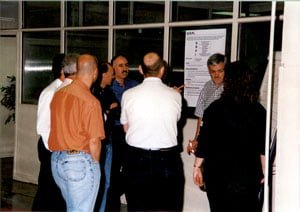
You can’t force a new culture on an unreceptive workforce. Introducing changes in culture involves a detailed programme for introducing new ideas in a participative way.
- Needs and assessments measurement – The first stage was a series of one-to-one interviews and focus group activities for representatives from all areas of the organisation. These identified the cultural strengths and the barriers to change at Halewood. These sessions were designed to find out how employees thought and felt about their work culture, and to provide the feedback to outline the strategy and the key messages for the culture change programme.
- Management workshops -The next phase involved a series of three day sessions for managers to build up a commitment to the change programme.
- Union workshops – Union leaders took part in workshops so they could better understand the new Jaguar approach to building cars on the basis of pride and dedication. This gained union support for the change and showed everyone what the benefits would be.
- Management and union workshop – Management and unions identified a joint approach to take the initiative forward and embrace the new values.
- Supervisors’ workshops – Supervisors were to play a key role in introducing the new ways of working. Supervisors’ workshops therefore concentrated on how they could help to lead the change process.
- Pilot workshops – Five pilot workshops of thirty participants taken from all levels of the organisation were trialled. The emphasis was on breaking down divisions within the organisation so that a new model of team working relationships could be established.
- Selection and training of internal facilitators – To cascade the Jaguar (Halewood) Difference message across the organisation, sixteen internal facilitators from all areas and levels of the organisation were selected and trained.
- Two day workshops for all employees – The final stage of the rollout of the culture change programme was a series of two-day workshops led by the internal facilitators. These sessions gave all 3,000 employees a clear understanding of the difference between working on a Ford Escort and creating the new Jaguar X400. They also heightened awareness of the Jaguar Difference values and behaviours.
The early phases of the new programme were very encouraging. It was immediately obvious that everyone had a common goal – to make a success of Halewood. By involving everyone in the culture change programme it was relatively easy to establish a shared vision. Through the workshops, employees built up real enthusiasm for the empowerment process. Employees were motivated by the fact that they had a role to play in the change process. For example, one employee commented favourably on the initiative when he stated, ‘I always thought the company wanted me to leave my brain at the gate’.
Conclusion
The success of the X400 production system at Halewood is based on three pillars.
- An emphasis on quality at every stage in the production of the new cars.
- The culture change programme – creating an empowered, entrepreneurial and committed workforce, and
- Establishing centres of excellent practice across the organisation which act as benchmarks for improving performance in areas carrying out similar operations.
New facilitators will take the change process forward even further. They are being coached by existing facilitators and throughout the organisation, employees are being formed into empowered teams to drive lean production forward. The Halewood plant will provide the benchmark for improvements across the Ford organisation in the UK.
Jaguar | Changing the culture at Jaguar
